Non-Disclosure Agreement (NDA) Template
Safeguard your confidential information with our Non-Disclosure Agreement. Begin by specifying the relationship between the parties.
A Non-Disclosure Agreement (NDA), also referred to as a confidentiality agreement, serves as a legally binding contract between two parties. In this agreement, one party discloses sensitive information, and the other commits to maintaining confidentiality. This confidential information often includes technical, commercial, or valuable data, such as trade secrets and proprietary information.
Understanding NDA Essentials
Both parties involved sign the NDA, solidifying a contractual commitment to keep the shared information confidential. If you're considering drafting your NDA, it's crucial to understand the intricacies involved. Our comprehensive NDA guide offers valuable insights into the key aspects of creating a robust Non-Disclosure Agreement.
Recent Developments in NDA Landscape:
On February 21, 2023, the National Labor Relations Board made a significant decision that could impact confidentiality clauses in severance agreements. According to the ruling, such clauses might infringe on employees' rights under sections 7 and 8(a)(1) of the National Labor Relations Act. This decision, a reversal of a 2020 ruling, may necessitate revisions to NDAs included in severance agreements between 2020 and 2023 to align with the new regulations.
Types of Non-Disclosure Agreements
- Definition: In a Unilateral NDA, only one party is disclosing confidential information. The recipient of the information agrees not to disclose or use it for their benefit.
- Definition: Unlike the Unilateral NDA, a Bilateral NDA involves both parties sharing sensitive information. Both parties commit to keeping each other's information confidential.
- Definition: This type involves three or more parties, where each agrees to protect the confidential information shared by the others. It's useful in complex business arrangements involving multiple stakeholders.
- Definition: Used for a specific transaction or business deal, a Transactional NDA outlines the confidentiality terms related to that particular event.
- Definition: A Perpetual NDA has no expiry date, meaning that the obligations of confidentiality continue indefinitely. It's often used for long-term or ongoing business relationships.
- Definition: This type restricts the use of confidential information to a specific purpose or project. Once that purpose is fulfilled, the confidentiality obligations may cease.
- Definition: Specifically crafted for employees, an Employee NDA ensures that staff members do not disclose sensitive company information both during and after their employment.
- Definition: Geared towards protecting the interests of the disclosing party, this type of NDA may have provisions that are more favorable to the party sharing confidential information.
- Definition: Conversely, a Receiving Party-Friendly NDA may have terms more favorable to the party receiving the confidential information.
- Definition: Used in business relationships with vendors or suppliers, a Vendor NDA ensures that confidential information shared in the course of the business relationship is protected.
- Definition: Tailored for corporate settings, this type of NDA addresses the unique needs and complexities of large organizations in safeguarding their confidential information.
- Definition: Specifically focused on protecting intellectual property rights, this NDA ensures that any shared innovations, designs, or inventions remain confidential.
Understanding the nuances of each type of NDA is crucial when crafting an agreement tailored to the specific needs of your business or collaboration. Always seek legal advice to ensure your NDA is legally sound and provides the necessary protection.
Purpose of a Non-Disclosure Agreement
The primary objective of an NDA is to safeguard confidential information from public disclosure or unauthorized use by parties privy to the information. By signing an NDA, a legal framework is established to protect intellectual property, preventing theft, sale, or sharing of sensitive information with external entities, including business competitors.
Key Applications of an NDA:
Protection of Sensitive Information: For individuals or companies dealing with sensitive data, an NDA ensures that participants are legally bound not to disclose or release information to unauthorized parties.
Safeguarding Patent Rights: Sharing trade secrets requires measures to ensure confidentiality. Including an NDA in such scenarios becomes a crucial step to protect patent rights.
Clarification of Confidential Information: An NDA delineates what information is deemed confidential, minimizing any potential confusion.
Examples of NDA Usage:
- In-depth Business Discussions: When engaging in detailed business talks, an NDA offers legal protection for shared sensitive information.
- Hiring Processes: NDAs are commonly used when hiring employees, freelancers, or contractors, ensuring that confidential information remains secure.
- Engaging with Investors: When working with potential investors, an NDA establishes a framework to safeguard proprietary data during discussions.
- Complementing Other Agreements: NDAs can supplement other agreements, such as manufacturing agreements, enhancing overall legal protection.
How to Write a Non-Disclosure Agreement
Here is a walkthrough on how to create and fill out an NDA, what are the standard clauses you should include, and what they mean:
Step 1 – Disclosing and Receiving Parties
Start your NDA by establishing the “Parties” to the agreement. The “Disclosing Party” is the individual or entity sharing information. At the same time, the “Receiving Party” is the individual or entity receiving information.
Confidential information has been shared in a mutual NDA (a bilateral NDA). In this agreement, both parties serve as the Disclosing and Receiving Parties.
Here’s an example of how to start an NDA and establish the Parties to the agreement. Notice that the sample NDA clause also specifies what transaction or relationship the NDA relates to:
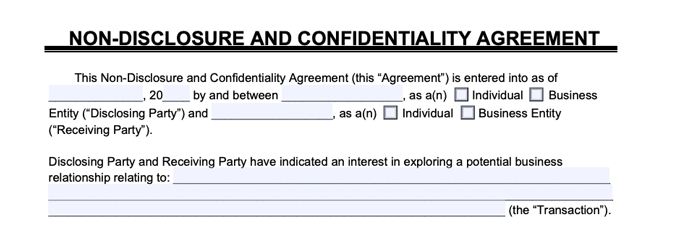
An example of where to show the parties involved in our NDA template.
Step 2 – Confidential Information
After the Parties have been established, specify what the Non-Disclosure Agreement protects confidential information.
Common examples of NDA-protected confidential information include:
Trade secrets
- Special formulas
- Practices
- Instruments
- Software development
- Technical designs
- Blueprints
- Customer lists
- Patent details
Business Ventures
- Affiliate deals
- Partnerships
- Mergers
- Real Estate
- Consultations
- Audits
- Advertising and marketing
- Pricing structures
- Business and financial records
Creative Endeavors
- Documentary, TV, film, and news production
- Illustrations, graphic design, and drawings
- Web design
- Inventions, prototypes, or product samples
- Recipes
Other
- Visitor or factory tours
- Bachelor or bachelorette parties
- Volunteering
- Celebrity meet-and-greets
- House tours
- Original artwork
These are only a few examples of the types of information you wish to keep confidential under the protection of your NDA. Your agreement can list as many or as few confidential information as needed. Still, it would help if you were specific about what information the Receiving Party cannot disclose.
Being specific about what your NDA protects information will help it stand up in court in a legal dispute.
Step 3 – Exclusions from Confidential Information
An “Exclusions” clause defines what information the NDA does not protect.
Information that a Non-Disclosure Agreement can’t protect includes:
- information already in the public domain
- information the other party already has access to before the NDA
- information that is independently developed or discovered by the recipient
- information that the Disclosing Party has authorized the Receiving Party to share with the prior written consent
Read More: Understanding Confidential Information in NDAs
Oral information can be deemed confidential if confirmed in writing within a specific time frame after being disclosed.
Here’s an example of what your Exclusions clause should look like:
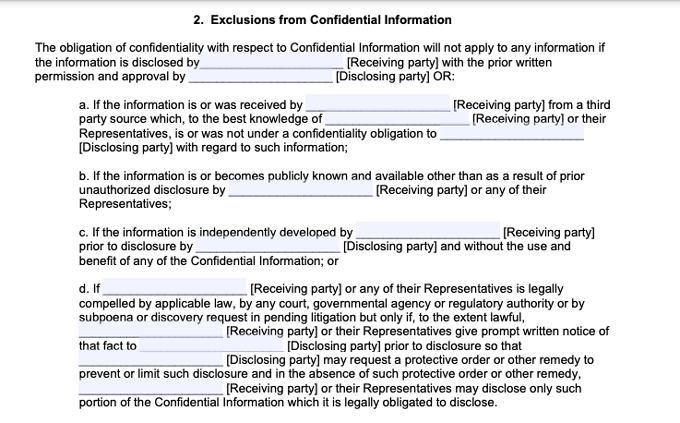
An example of where to detail information regarding exclusions in our NDA template.
Step 4 – Non-Disclosure Obligations
The bulk of your NDA will comprise Non-Disclosure Obligations, which outline the Receiving Party’s obligations to the Disclosing Party’s information.
Rather than being a single clause, this section will likely comprise multiple clauses that detail various obligations.
This section will start with a clause like in the example below, which states the general obligation of the Receiving Party to keep the confidential information quiet.
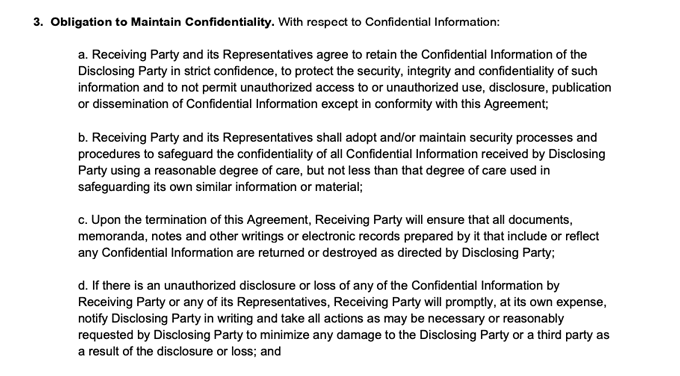
An example of where to include an obligation to maintain confidentiality information in our NDA template.
Depending on your needs, you can add additional clauses to this section of your NDA. Here are some other provisions you may choose to include in your Non-Disclosure Obligations section:
1. Non-Disclosure of Transaction: the Receiving Party promises not to let others know that:
- The Disclosing Party has shared or used Confidential Information.
- a Transaction is being discussed or negotiated.
- a Transaction has taken place, including the details of the relationship.
2. Non-Solicitation: either party may prevent the other from soliciting or offering employment to the other party’s employees or diverting business from the other party.
3. Non-compete: Parties agree not to engage in business activities directly competing with the other party. Many companies have partners and employees sign NDAs and non-compete agreements separately.
4. Non-Circumvention: if the Disclosing Party shares business contacts, a non-circumvention clause prevents the Receiving Party from bypassing the agreement and directly doing business or engaging with those contacts.
In the NDA sample below, you can see how these clauses may look in an agreement:
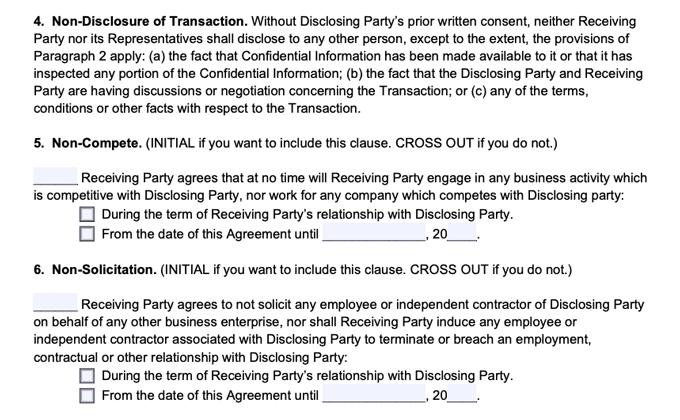
An example of different obligations clauses in our NDA template.
You may include only a few examples of Obligation clauses in your NDA.
Step 5 – Time Frame / Termination
The NDA should explicitly state how long it remains in effect. The Time Frame includes when the promise to keep confidential information secret begins (the “Effective Date“) and the duration in which the protected information must not be shared with others (the “Disclosure Period“).
Usually, the Parties agree to when the term of the agreement will end (known as the “Termination” provision). For example, the Non-Disclosure Agreement could terminate when:
- the Agreement expires
- the Transaction is completed; or
- a specific period has passed.
Step 6 – Jurisdiction
The Jurisdiction clause establishes which state’s laws govern the Confidentiality Agreement. Suppose confidential information is leaked or inappropriately used by one party, and a lawsuit ensues. In that case, the laws of the agreed-upon state will apply, and any trials or hearings will occur there.
Step 7 – Signatures
Finally, your NDA needs to include the signatures of all Parties and their Representatives.
Representatives are other people (i.e., directors, officers, employees, agents, or advisors) who may share, receive, or protect the information in pursuit of the Transaction specified in the NDA.
Here’s an example of the Disclosing Party’s signature section:
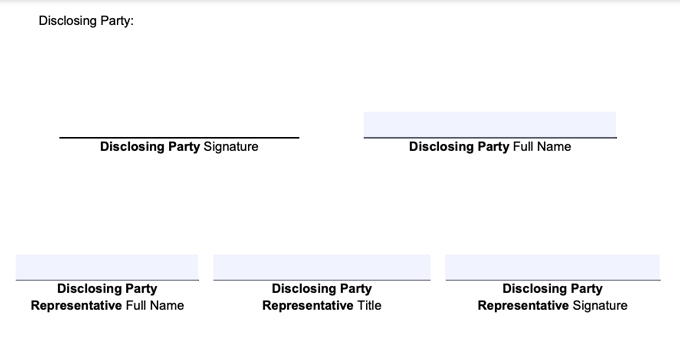
An example of where to sign in our NDA template.
Directly below this is the Receiving Party’s signature section, which is identical.
Step 8 – Additional Clauses
Every NDA will look different depending on the nature of the transaction, relationship, and information being specified. There are additional clauses you may choose to include in your Confidentiality Agreement:
- Remedies: stipulates the consequences of breaking the NDA
- No License: provides that the NDA doesn’t give either party any patent, copyright, or ownership of the information provided.
- Severability: states that if one part of the NDA is ruled invalid in court, that part will be removed, and the rest of the agreement remains valid.
- Amendments: notes that the NDA may be amended at any time.
Frequently Asked Questions
What kind of information can be protected under an NDA?
NDAs typically cover sensitive, technical, commercial, or valuable information, including trade secrets, proprietary data, and intellectual property.
Can NDAs be used in various business scenarios?
Yes, NDAs are versatile and can be used in scenarios such as business discussions, employee hiring, engaging with investors, and complementing other agreements.
What should I do if there's a change in NDA regulations affecting my existing agreements?
If there are changes in regulations, it's advisable to consult with a legal professional to assess the impact on your existing agreements and make any necessary revisions to comply with the new rules.
Sample Non-Disclosure Agreement
Page 1 of
- Mutual Non-Disclosure Agreement (NDA) : Utilize our Mutual Non-Disclosure Agreement to ensure the protection of both your confidential information and that of the other party.
- Photo Licensing Agreement : Utilize our Photo Licensing Agreement to grant licenses for your owned photos.
- Confidential Information & Inventions Assignment (CIIA) Agreement : Use a CIIA Agreement to protect your intellectual property and all work produced by employees on company time.